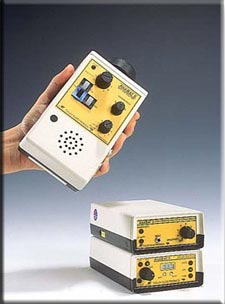Bats can see as well as humans can, but they have evolved a sophisticated method of using sound that enables them to navigate and find food in the dark called echolocation. Bats produce echolocation by emitting high frequency sound pulses through their mouth or nose and listening to the echo. With this echo, the bat can determine the size, shape and texture of objects in its environment. Bat echolocation is so sophisticated that these animals can detect an object the width of a human hair.
Shouting Bats & Whispering Bats
Bats can be broadly characterized by their echolocation calls as shouting bats and whispering bats. Big brown bats and little brown bats are shouters and produce sounds (if we could hear them) of 110 decibels or similar to the loudness of a smoke alarm. Northern long-eared bats are whispering bats and produce sounds of 60 decibels (similar to the levels of normal human conversation). Shouters tend to forage for food in open spaces; whisperers glean insects from the foliage of trees and forage in the cluttered environments of forest interiors.
Not All Bats Echolocate
About 70% of all bat species worldwide have this ability. Also, bats aren't the only animals that use echolocation. Whales, dolphins, porpoises, oilbirds and several species of shrews, tenrecs, and swiftlets use a similar technique.
Most bat echolocation occurs beyond the range of human hearing. Humans can hear from 20 Hz to 15-20 kHz depending on age. Bat calls can range from 9 kHz to to 200 kHz.
Some bat sounds humans can hear. The squeaks and squawks that bats make in their roosts or which occur between females and their pups can be detected by human ears, but these noises aren't considered to be echolocation sounds.
All Bats in Maryland Echolocate
All bats in Maryland echolocate and all eat insects. Lots of them. Bats can eat more than 50% of their body weight in insects each night. Nursing females may eat their entire body weight each night-as many as 4,500 or more small insects, including insects which are agricultural pests or garden pests. One study documented that a big brown bat maternity colony of 150 bats ate 38,000 cucumber beetles, 16,000 June beetles, 19,000 stinkbugs, and 50,000 leafhoppers in a summer!
Moths are food for many bats and some moths have evolved many interesting tactics to survive bat attacks. Some species have fuzzy wings that will reflect bat echolocation pulses. Other moths in the families Noctuidae and Arctiidae have "ears" which can sense bat echolocation. These "ears" are membranes stretched over sensors and can be located on the head, body or wings of the moth. Once a bat is detected, these moths may fly in loops, make noises to startle the bat, or fold up their wings and dive to avoid capture.
Some bats have evolved methods to counter moth evasive maneuvers such as producing pulses that can detect fuzzy wings. Other bats will use frequencies beyond the range of insect hearing or confuse insects by flying erratically. Bats also fly erratically in the act of catching insects. Although bats will catch insects on the fly with their mouths, they also can scoop insects with their tail or wing membrane and then reach down and snatch the insect with their mouth. This maneuver results in the erratic flight people observe when bats are feeding.
Eavesdropping on Bats
Humans have also devised methods for eavesdropping on bats. Bat detectors are machines with ultrasonic microphones that can detect bat echolocation and output the incoming call within the range of human hearing, allowing bat enthusiasts to "hear" bats as well as see them searching and catching food. With experience, bat detectors can be useful tools to determine bat presence or absence in an area.

Photo of Anabat Detector
Courtesy of Titley Electronics Pty Ltd
Manufacturers of the Anabat bat detection and identification system, and radio telemetry equipment - operating under a quality system, based on the International Standard, ISO 9002. P.O. Box 19, Ballina NSW 2478, Australia - www.titley.com.au